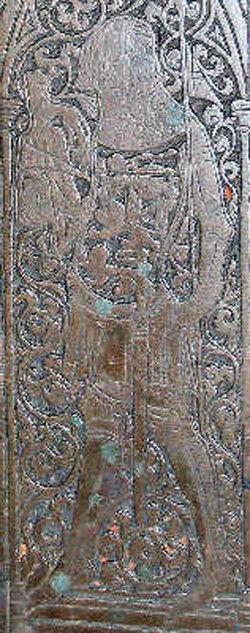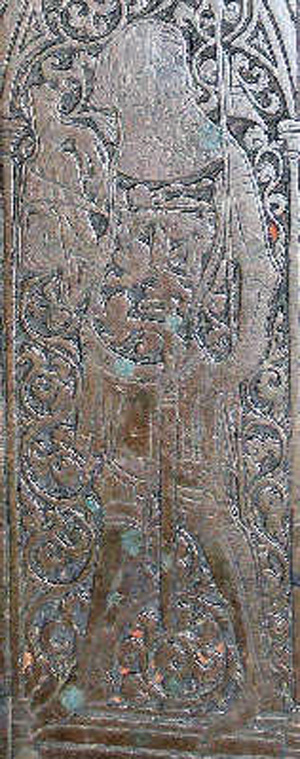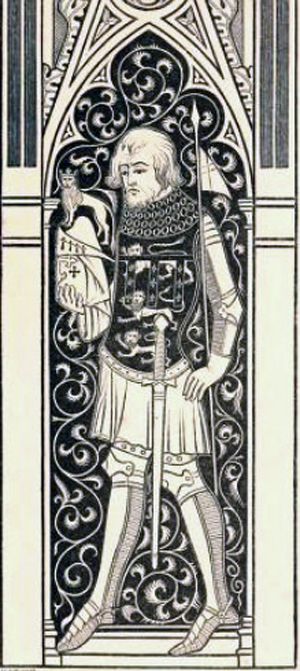Lord of Monmouth and Threecastles. In right of his wife, of East Garston and North Standen in Hungerford, Berkshire, of Lillingstone Dansey, Buckinghamshire, of Etloe Duchy in Awre and Kempsford, Goucesterhire, of King's Somborne, Hampshire, of Kidwelly, Carmarthenshire, of Ogmore Glamorgan.
Second son of Edmund "Crouchback' Plantagenet and Blanche d'Artois, Queen of Navarre. Grandson of King Henry III and Eleanor of Provence, Robert I, Count of Artois and Mathilde Brabant.
Husband of Matilda de Chaworth, daughter of Sir Patrick de Chaworth and Isabel de Beauchamp, daughter of William, Earl of Warwick. They were married after 30 Dec 1291, the grant of her marriage and before 02 March 1297. Mathilda was a wealthy heiress whose marriage granted massive properties to Henry. They produced one son and six daughters:
* Henry, Earl of Derby, Duke of Lancaster
* Blanche, wife of Baron Thomas Wake
* Maud, wife of William de Burgh, Earl of Ulster
* Joan, wife of Baron John de Mowbray
* Isabel, Abbess of Amesbury
* Eleanor, wife of John de Beaumont & Richard FitzAlan Arundel
* Mary, wife of Baron Henry de Percy
Maud died before 03 Dec 1322, buried at Mottisfort Priory.
Secondly, the husband of Alice de Joinville, daughter of Jean de Joinville, Seneschal de Champagne and Alice de Risnal, married after 1322.
Henry received Monmouth and lands in 1297 after his father's death in 1296. He was at the Battle of Falkirk 1298, summoned to Parliament 06 Feb 1299 as Henrico de Lancastre nepoti Regis (kinsman of the King) whereas he became Lord Lancaster. Henry was at the siege of Caerlaverock in 1300, and signed the Baron's letter to Pope Boniface in 1301 as D'n's de Munemue. He helped John le Harper escape from prison, but was pardoned for his part in 1307. Henry and Maud attended the coronation of King Edward II in 1308, was one of the men who forced the king to agree to the Lord Ordainers, and joined the marcher lords against Llywelyn Bren in 1315. His brother, John, died in France, requiring Henry to journey there to obtain his heritage in 1318.
Henry joined the Marchers against the Despensers in 1320, petitioned the king for, and received, the earldoms of Lancaster and Leicester when his brother, Thomas, was executed for his rebellions against the king by the Despensers in 1322.
Henry joined Queen Isabella and Roger de Mortimer against Edward II, sent to capture Edward at Neath in South Wales, taking the king to Glamorgan and next to Kenilworth Castle, where he remained in Henry's custody until 04 April 1327.
Henry was at the coronation of King Edward III 1327, but refused to attend Parliament in 1328, quarreling with the Queen who sent her forces to ravage Henry's Leicester lands, Henry's armed were defeated by Mortimer, and Henry received his lands back again. After Mortimer's demise, Henry and Edward became close again, the King granted Henry 500 marks annually for the maintenance of his estate. Henry was with Edward at the planning of the Scottish invasion in 1335, appointed to the Council of Edward's son, Prince Lionel, Keeper of England, during the King's travels in 1345.
In 1330 Henry, Earl of Lancaster founded a hospital on this site immediately to the south of the castle just outside the borough walls. This was substantially enlarged by his son, Henry, Duke of Lancaster who increased the size of the hospital and added to it a large and richly endowed chantry college to form the hospital and College of the Annunciation of St Mary in the Newarke. http://digitalbuildingheritage.our.dmu.ac.uk/
Apparently, Henry went blind about 1330.
Henry was buried on the north side of the high altar at "Newark Abbey" which is actually the Church of St. Mary of the Annunciation, also known as St. Mary-in-the-Newarke.
Lord of Monmouth and Threecastles. In right of his wife, of East Garston and North Standen in Hungerford, Berkshire, of Lillingstone Dansey, Buckinghamshire, of Etloe Duchy in Awre and Kempsford, Goucesterhire, of King's Somborne, Hampshire, of Kidwelly, Carmarthenshire, of Ogmore Glamorgan.
Second son of Edmund "Crouchback' Plantagenet and Blanche d'Artois, Queen of Navarre. Grandson of King Henry III and Eleanor of Provence, Robert I, Count of Artois and Mathilde Brabant.
Husband of Matilda de Chaworth, daughter of Sir Patrick de Chaworth and Isabel de Beauchamp, daughter of William, Earl of Warwick. They were married after 30 Dec 1291, the grant of her marriage and before 02 March 1297. Mathilda was a wealthy heiress whose marriage granted massive properties to Henry. They produced one son and six daughters:
* Henry, Earl of Derby, Duke of Lancaster
* Blanche, wife of Baron Thomas Wake
* Maud, wife of William de Burgh, Earl of Ulster
* Joan, wife of Baron John de Mowbray
* Isabel, Abbess of Amesbury
* Eleanor, wife of John de Beaumont & Richard FitzAlan Arundel
* Mary, wife of Baron Henry de Percy
Maud died before 03 Dec 1322, buried at Mottisfort Priory.
Secondly, the husband of Alice de Joinville, daughter of Jean de Joinville, Seneschal de Champagne and Alice de Risnal, married after 1322.
Henry received Monmouth and lands in 1297 after his father's death in 1296. He was at the Battle of Falkirk 1298, summoned to Parliament 06 Feb 1299 as Henrico de Lancastre nepoti Regis (kinsman of the King) whereas he became Lord Lancaster. Henry was at the siege of Caerlaverock in 1300, and signed the Baron's letter to Pope Boniface in 1301 as D'n's de Munemue. He helped John le Harper escape from prison, but was pardoned for his part in 1307. Henry and Maud attended the coronation of King Edward II in 1308, was one of the men who forced the king to agree to the Lord Ordainers, and joined the marcher lords against Llywelyn Bren in 1315. His brother, John, died in France, requiring Henry to journey there to obtain his heritage in 1318.
Henry joined the Marchers against the Despensers in 1320, petitioned the king for, and received, the earldoms of Lancaster and Leicester when his brother, Thomas, was executed for his rebellions against the king by the Despensers in 1322.
Henry joined Queen Isabella and Roger de Mortimer against Edward II, sent to capture Edward at Neath in South Wales, taking the king to Glamorgan and next to Kenilworth Castle, where he remained in Henry's custody until 04 April 1327.
Henry was at the coronation of King Edward III 1327, but refused to attend Parliament in 1328, quarreling with the Queen who sent her forces to ravage Henry's Leicester lands, Henry's armed were defeated by Mortimer, and Henry received his lands back again. After Mortimer's demise, Henry and Edward became close again, the King granted Henry 500 marks annually for the maintenance of his estate. Henry was with Edward at the planning of the Scottish invasion in 1335, appointed to the Council of Edward's son, Prince Lionel, Keeper of England, during the King's travels in 1345.
In 1330 Henry, Earl of Lancaster founded a hospital on this site immediately to the south of the castle just outside the borough walls. This was substantially enlarged by his son, Henry, Duke of Lancaster who increased the size of the hospital and added to it a large and richly endowed chantry college to form the hospital and College of the Annunciation of St Mary in the Newarke. http://digitalbuildingheritage.our.dmu.ac.uk/
Apparently, Henry went blind about 1330.
Henry was buried on the north side of the high altar at "Newark Abbey" which is actually the Church of St. Mary of the Annunciation, also known as St. Mary-in-the-Newarke.
Family Members
-
Blanche Plantagenet Wake
1305–1380
-
![]()
Sir Henry of Grosmont
1310–1361
-
Matilda of Lancaster Ufford
1310–1377
-
![]()
Joan Plantagenet Mowbray
1312–1349
-
![]()
Lady Eleanor 'of Arundel' Plantagenet FitzAlan
1318–1372
-
![]()
Eleanor Plantagenet FitzAlan de Arundel
1318–1372
-
![]()
Lady Mary Plantagenet Percy
1320–1362
-
Isabel de Plantagenet
unknown–1349












